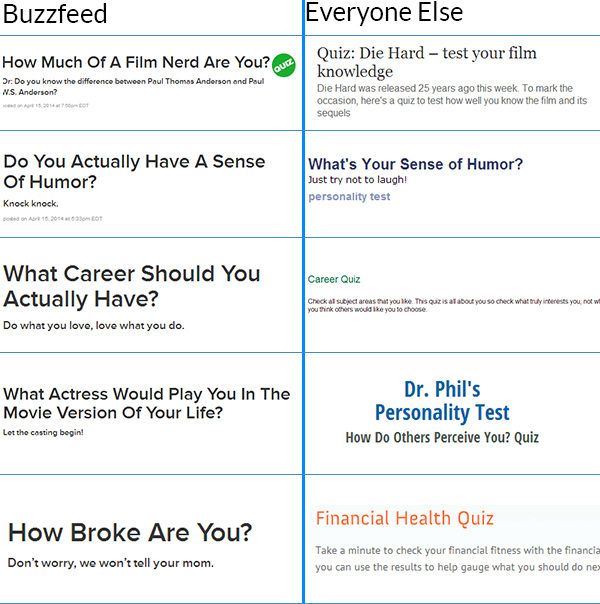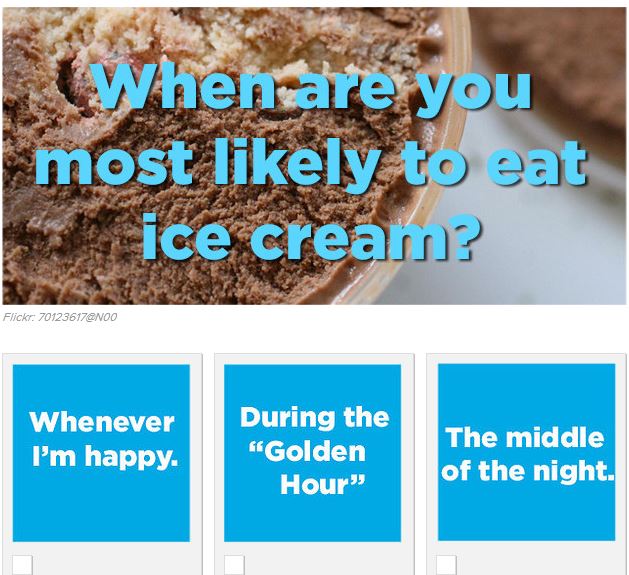10+ tips to plan, build and share more engaging quizzes
This New York Times article highlights the reasons behind the growing popularity in online quizzes amongst consumers. Quizzes are great fun and can be an excellent way to drive traffic, but not all quizzes are created equal. There is a certain art to building and distributing a quiz that must be perfected in order to maximize the effect of your efforts. After analyzing over 1000 quizzes built using Interact, here’s what I’ve learned.
Building a quiz
1. Get the name right
80% of people make a decision about whether or not they should check out an article based on the title. That’s why you should spend a minimum of 20% of your time researching and testing out headlines.
When Upworthy first began their rise to power, they became famous for their '25 Headline' approach, in which they would actually write out 25 different headlines for each article before deciding on one to actually use.
Writing out those many headlines might seem crazy, but by about number twenty-one your mind gets very creative and sometimes amazing ideas pop out.
In general, there are a couple of quiz titles that work very well as go-tos.
- The 'Actually' Headline: 'How Much do You Actually Know About Your Home Country?' In reality this is just a knowledge quiz, but by adding the word actually it becomes a challenge.
- The Celebrity Comparison Headline: 'Which Celebrity Would Play You in a Movie Version of Your Life?' This is a personality quiz disguised as something more playful. It starts out life as a regular personality quiz and then you add celebrities to make it more appealing.
- The Introspection Quiz: 'Which Country Should You Actually Live In?' The addictive feature of this type of quiz is that it appeals to our inner desire to know more about ourselves. When we talk about ourselves our brain activity lights up like a Christmas tree, and this quiz takes advantage of that.
To illustrate just how much of a difference headlines can make, check out this side-by-side comparison of Buzzfeed quiz titles versus regular quiz titles found on other site.

2. Write snarkily
A quiz is a conversation between you and your web visitors. In real life do you ask questions where the possible answers are 'Never, sometimes, always?' Probably not, unless you are a robot, and then none of this applies to you anyway.
The beauty of quizzes is their ability to create one-on-one conversation between two people who may be in different places at different times, and come from completely different backgrounds.

However, that beauty also presents a challenge for quiz writers who must come off as genuine without being boring. What Buzzfeed has done is taken the goofy route, writing quizzes like a slightly tipsy college student.
This works for them, but you must find your own style. Think about what makes you unique as a writer and exploit it in your quiz writing style.
3. Use images
A study of 32 Buzzfeed quizzes found that the ones using a picture of a face as the thumbnail received nearly 50% more traffic than those that didn’t.
Our brains are wired to look for faces, which is probably the reason we see them everywhere (on toast, on the surface of distant planets, etc.). Having a face on your quiz can be an effective way to draw eyeballs in.
Additionally, the average Buzzfeed quiz uses ten images in results and questions. When creating a quiz, you must fight the stereotype of school quizzes, and images are one way to effectively negate any sort of academia.
4. Be overly positive
Quizzes appeal to the narcissist that lives in all of us. We enjoy finding out how great we are but get bummed out if we are diagnosed as anything less than awesome. That’s why every single result for the most popular quizzes sweeping across the web have a set of result personalities that are completely upbeat.
It might sound easy to remain encouraging, but it’s not. Here are a few tips to boost egos without coming across as a phony.
- Use opposites: 'You can be the life of the party, but sometimes you need quiet time.' This statement covers literally almost everyone and makes people feel good about themselves.
- Use general specifics: 'You are amazing at some things, but not so great at others, and that’s okay!' Once again, this applies nearly universally, and boosts self esteem.
- Use references: 'You are like Dennis Quad.' Dennis Quad is a popular figure who seems quite cool, but we don’t really know who he is. That way the statement applies to a broad range of people while still appearing specific.
5. Keep it short
Our attention span is just 60 seconds when we’re browsing online. That’s why the average Buzzfeed quiz is just ten questions and can be completed in under a minute. Since every result is positive, the actual accuracy of quizzes is not so important, and Buzzfeed itself is famous for not having reliable results.
When possible, condense your questions down to eliminate unnecessary ones, and only include questions that can be tied directly to your results.
6. Talk to a person
Think of one individual who would enjoy your quiz and talk to them. This will help you write more naturally and in a fun way. Also, when quiz takers share your quiz, they will probably have someone else in mind who would enjoy it, and if the quiz is written in a way that talks to a person it’s much easier to share.
Here are a few tips for writing to a person instead of an audience.
- Use personal pronouns: Avoid addressing a crowd of people. A quiz is a much more personal medium than written articles, and you and talk to a person. For example, make a possible quiz answer choice 'I like cookies' instead of just 'Cookies.'
- Drop the formality: You wouldn’t talk to a buddy the same way you’d deliver a speech, so don’t write quizzes like they’re speeches.
- Get edgy: Going back to the snarky point, edginess can endear your readers to your quiz.
Sharing a quiz
1. Facebook: The social network is responsible for the largest share of quiz traffic. By optimizing your quiz results, you can create highly share-able rich snippets that can drive traffic back to your site.
There is a formula for getting the sharing portion right. 'I Got (result title, quiz title)' that way the person sharing not only gets to share their specific result, but also is calling all of their friends to action at the same time.

Additionally, you can also embed your quiz as a custom Facebook tab to act as a staple on your Facebook page as a tab, be sure to write on an evergreen subject that won’t fade when the latest trend is over.
2. Twitter: The micro-blogging site comes in second only to Facebook for driving quiz traffic. The same share formula is used to share on Twitter and expand the reach of your quiz.
3. Email: Email is the most natural and oldest of social sharing. Everyone knows how to hit the 'forward' button or compose a new message. Since your quiz is written in a style that appeals to one person, it’s easier for that person to pass the quiz on to one more person. While email does not have the mass appeal of Facebook or Twitter, it holds more power because we are likely to read an email forwarded by a friend.
4. Your Blog: Quizzes can be embedded just like YouTube videos through an iframe and be used as blog posts. Placement on your own URL is ideal because any backlinks and shares that come out of the quiz will be pointed to your domain and not Facebook.

Now to make your quiz
Unfortunately a quiz can't just be written like a blog post, you've got to have some technology to make it work. Good news though, several companies have stepped up to the plate and created platforms for making and deploying quizzes.
Here are my top three tools for making your quiz:
- 1. Interact: A new quiz builder most popular for creating Buzzfeed style quizzes that can be branded like your business.
Pros: Custom design at a low price (starting at $29 per month
Cons: A somewhat complicated scoring system can make it difficult to create accurate quizzes.

- 2. Snapapp: A legacy player in the interactive content space, Snapapp has worked with brands like the LA Times and National geographic
Pros: Strong technology and ability to customize at a deep level
Cons: High price point (starting at $999 per month)

- 3. Playbuzz: On the opposite end of the spectrum from Snapapp falls Playbuzz, a site very similar to Buzzfeed where you can make your own quiz.
Pros: Playbuzz quizzes have excellent design and are highly share-able. All of their questions and answers are based on images which makes them look amazing.
Cons: There is no custom branding, all Playbuzz quizzes look the same and often include links back to the Playbuzz site.

We are in the age of Interactive content, and quizzes have quickly jumped into the lead as the preferred form of conversational posts. People love taking quizzes, but only if they are done right and shared in a way that can be passed on easily. People are eager to take your quiz, follow the principles above and watch traffic soar!
Hi, I'm Josh. I started a company called Interact that makes interactive quizzes. I write for Yahoo, Salesforce, and Oracle among others, usually about what I've learned from creating thousands of quizzes. I love chatting about how we can make the web a more conversationally friendly place, hit me up on twitter
@jhaynam











